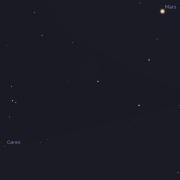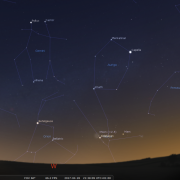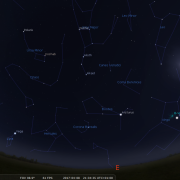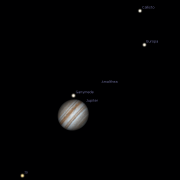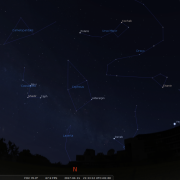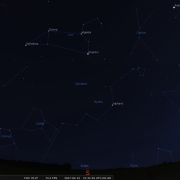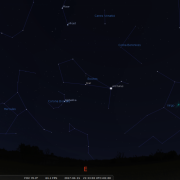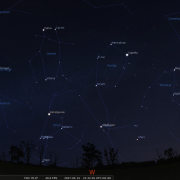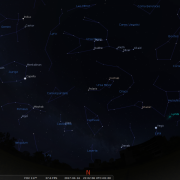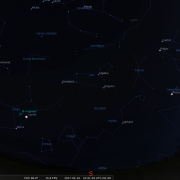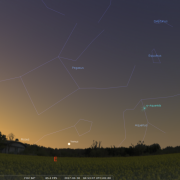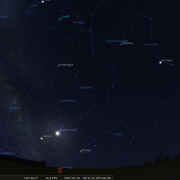Welcome to the WDAS monthly newsletter for April 2017: a digest of the month's latest contributions to our website. Below you'll find Society News, Sky Notes and In-Focus articles printed in full. There's also future events, and trailers for other articles which appear in full on the website - just a click away!
On the website you'll also be able to comment on articles, and if you'd like to play an editorial role in creating new content, just let us know!
Society News
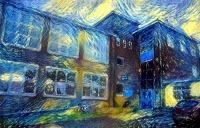 I don’t believe it! The Eskdale ‘Star night’ (Wednesday 22nd) unfortunately coincided with the only bad weather night of the week so our planned outdoor observations were quite out of the question. No scopes then, but with a new looking inflatable planetarium brought over and manned by York University boffins, who needed clear skies. All we needed was somewhere to use for the scale solar sytem(s). An ideal location was at hand – the main school corridor, which at nearly 60 mtrs long was tailormade for our demo.
I don’t believe it! The Eskdale ‘Star night’ (Wednesday 22nd) unfortunately coincided with the only bad weather night of the week so our planned outdoor observations were quite out of the question. No scopes then, but with a new looking inflatable planetarium brought over and manned by York University boffins, who needed clear skies. All we needed was somewhere to use for the scale solar sytem(s). An ideal location was at hand – the main school corridor, which at nearly 60 mtrs long was tailormade for our demo.
I say system(s) because two scale systems were laid out over the floor tiles; the Trappist1 system – recently highlighted in the media due to the number of ‘habitable zone planets’ detected, as well as our own system. At less than half a metre, the Trappist system really didn’t stretch our legs along the corridor, but it did bring home just how ‘intimate’ this seven planet system is huddled around its red dwarf sun. Our own system did though task the legs of participating school pupils and parents, the narrow confines seemingly focusing the mind on the distances of the outer planets.
Perhaps not the evening we were hoping for, but feedback post event was very positive, stimulating the old brain cells in young and old alike. Thanks to both ‘Andies’ for their help, either making the Trappist system or assistance on the night.
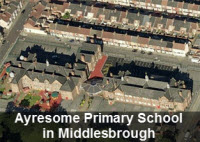 Just to reminder that we shall be hosting a star party event for visiting pupils from Ayresome Primary School & Lego Innovation Studio up at the Whitby Youth Hostel on April 12th. Elizabeth Labelle; assistant Head Teacher was impressed with the pupil response and feedback after last year’s inaugural event, and has contacted the society with regards to host another one this year. The start time is around 20:30h at the WHA on the east cliff.
Just to reminder that we shall be hosting a star party event for visiting pupils from Ayresome Primary School & Lego Innovation Studio up at the Whitby Youth Hostel on April 12th. Elizabeth Labelle; assistant Head Teacher was impressed with the pupil response and feedback after last year’s inaugural event, and has contacted the society with regards to host another one this year. The start time is around 20:30h at the WHA on the east cliff.
Cosmology Corner
 It all started in 1924, when Edwin Hubble proved galaxies are very distant objects, each containing millions or billions of stars, bound together by gravity. Within a few years, he set up a system to classify these galaxies by shape; a system which is still pretty much the system we use today.
It all started in 1924, when Edwin Hubble proved galaxies are very distant objects, each containing millions or billions of stars, bound together by gravity. Within a few years, he set up a system to classify these galaxies by shape; a system which is still pretty much the system we use today.
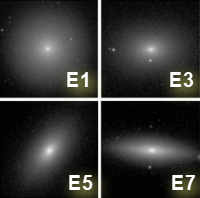 Eliptical galaxies
Eliptical galaxies
- Elipticals are marked with the letter E, sub-divided 0-7, where 0 is completely round and 7 is very elongated and flattened.
- The contain many old stars with very little dust between them. As stars form from dust, that kind of makes them dying galaxies without the raw ingredients to form many new stars.
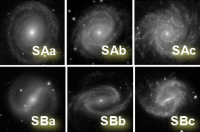 Spiral Galaxies
Spiral Galaxies
- There are Regular spirals (S) and barred spirals (SB). About 2/3 of spiral galaxies have a bar, probably including our own Milky Way. Spiral galaxies are sub-divided A-C where A has spirals tightly wound around the central bulge and in C the spirals are very loose.
- They have a mixture of old and new stars, which are particularly created in their spiral arms.
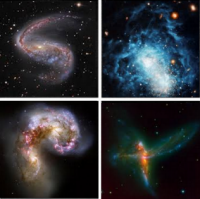 Irregular galaxies
Irregular galaxies
- Irregulars have a disk around a central bulge, but no obvious dust lanes. The have no sub-divisions.
- They often have many bright young stars. Galaxies can change their shape over time through interactions, collisions and mergers. These interactions stimulate massive star formation. If you're thinking that irregular galaxies have been messed-up and shaken-up by this kind of interaction, you're on the right track.
Galaxies also come in a range of sizes
- The Milky Way is a large galaxy (although there are many both larger and smaller).
- There are also Dwarf galaxies, like the near-by Small and Large Magellanic Clouds. Astronomers think that the total mass of all Dwarf galaxies exceeds the mass of the Large galaxies.
Changes to Hubble's galaxy classifcation system consider brightness, and whether arms spiral outward from a ring of stars. These changes help astronomers to understand more about their birth and eventual death.
 The video and material for this article was made by UK Astrophysicist Sebastian Pines, creator of the 'Astronomic' YouTube channel. You can support Seb's work creating videos that help to teach the world about astronomy by sponsoring a dollar or two per month via his Patreon page.
The video and material for this article was made by UK Astrophysicist Sebastian Pines, creator of the 'Astronomic' YouTube channel. You can support Seb's work creating videos that help to teach the world about astronomy by sponsoring a dollar or two per month via his Patreon page.
Sky Notes
In this month's Sky Notes:
Planetary Skylights
 Mercury remains on view low in the evening twilight sky until the second week of April. Look for the elusive planet across in the west approximately 45 minutes after sunset. On the 1st Mercury reaches greatest eastern elongation from the sun (greatest separation in the sky) but thereafter rapidly falls back toward the horizon, fading as it does so and is lost to view after the 12th.
Mercury remains on view low in the evening twilight sky until the second week of April. Look for the elusive planet across in the west approximately 45 minutes after sunset. On the 1st Mercury reaches greatest eastern elongation from the sun (greatest separation in the sky) but thereafter rapidly falls back toward the horizon, fading as it does so and is lost to view after the 12th.
 Mars is also visible low in the west, upper left of Mercury (or mercury lower right of Mars) The red planet is slowly (very slowly) losing ground in the bright twilight, but will still be visible at the end of the month. On the 10th Mars lies less than 3 degrees upper right of the dwarf planet Ceres, which should be visible in a pair of binoculars. From mid month Mars moves up (seemingly) between the star clusters of the Pleiades and the Hyades, both in Taurus. A crescent moon joins them on the 28th making for a pleasing spectacle to the naked eye.
Mars is also visible low in the west, upper left of Mercury (or mercury lower right of Mars) The red planet is slowly (very slowly) losing ground in the bright twilight, but will still be visible at the end of the month. On the 10th Mars lies less than 3 degrees upper right of the dwarf planet Ceres, which should be visible in a pair of binoculars. From mid month Mars moves up (seemingly) between the star clusters of the Pleiades and the Hyades, both in Taurus. A crescent moon joins them on the 28th making for a pleasing spectacle to the naked eye.
|
10-Apr-2017, 21:15h:
Mars and Ceres Click for full-sized image |
28-Apr-2017, 21:45h:
(looking South): Mars and Moon Click for full-sized image |
 Mighty Jupiter takes centre stage in the April night sky coming to opposition on the 7th when it resides due south at midnight. Look for the beacon of Jupiter low down in the south east as twilight begins to fall. Observing Jupiter is a must for anyone with a telescope; even binoculars will reveal the Galilean moons. Note the dark banding across the disk, and if visible the great red spot, which will appear as pale oval hollow on the southern dark equatorial belt. A modest telescope should reveal it, however as Jupiter rotates in less than ten hours, the GRT is not always orientated in our direction. Incidentally the star below Jupiter is Spica – chief star in Virgo. A waning moon resides close by on the 10th.
Mighty Jupiter takes centre stage in the April night sky coming to opposition on the 7th when it resides due south at midnight. Look for the beacon of Jupiter low down in the south east as twilight begins to fall. Observing Jupiter is a must for anyone with a telescope; even binoculars will reveal the Galilean moons. Note the dark banding across the disk, and if visible the great red spot, which will appear as pale oval hollow on the southern dark equatorial belt. A modest telescope should reveal it, however as Jupiter rotates in less than ten hours, the GRT is not always orientated in our direction. Incidentally the star below Jupiter is Spica – chief star in Virgo. A waning moon resides close by on the 10th.
|
08-Apr-2017, 21:30h:
Moon and Jupiter Click for full-sized image |
07-Apr-2017: Jupiter with
Moons at Opposition Click for full-sized image |
 Saturn rises in early morning hours and is best viewed telescopically shortly before dawn (around an hour). Saturn resides to the left of a bright red star – Antares, chief star of Scorpius. Look on the 16th when a waning crescent moon lies upper right of Saturn.
Saturn rises in early morning hours and is best viewed telescopically shortly before dawn (around an hour). Saturn resides to the left of a bright red star – Antares, chief star of Scorpius. Look on the 16th when a waning crescent moon lies upper right of Saturn.
 Finally, at the end of April Venus emerges into the dawn sky around 05:00h very low to the east horizon.
Finally, at the end of April Venus emerges into the dawn sky around 05:00h very low to the east horizon.
Meteor Showers

The Lyrid meteor shower peaks during the day of April 22nd , so the night of 21/22 and 22/23rd should yield some visible shooting stars, especially as the moon will be out of the way. The hourly rate exceeds 25, however observed
rates will at best be half this. As with all meteor showers the early morning hours offer the best returns.
A number of lesser meteor showers occur during April. The Virginids and alpha Scorpiids each have zenith hourly rates (ZHR) of around half a dozen, equating to ‘normal’ sporadic meteor activity levels. The Virginids peak on April 7/8th, which is a ‘no moon’ window, therefore increased sightings of Virginids during the early morning hours is quite likely. The Scorpiids peak on the 27th and will be hampered a little by a waning moon in the early morning hours.
Comet 41P Tuttle-Giacobini-Kresák
Yes I know, yet another mouthful, but you may call it Comet 41P or even Comet TGK, and hopefully it should be visible from the last week of March and well into April. At its closest on April 5th, the comet will be moving a huge two degrees a day (that’s the width of four Full Moons!) as seen from the Earth passing through the celestial dragon of Draco.
Orbiting the Sun once every 5.4 years, this is the 29th perihelion return of the comet since its discovery in 1858. The comet’s orbit takes it out to near the orbit of Jupiter with perihelion just 0.13 AU outside the orbit of the Earth. The comet’s passage in 2017 is about as close as it gets to Earth, indeed it is the closest approach in our lifetime. Currently around +9th magnitude, the comet should flirt with naked eye visibility of (magnitude +6) in early April. Comet 41P is also worth watching, as it’s known for periodic outbursts, reaching mag +3.9 in 1973.
However please remember comets should come with a observational health warning –so to speak- ;ie they hardly ever do what they are supposed to do. So if you are going to track 41P down, pick a dark window night, have patience and use a star chart (actually it can be more fun than it sounds) Use binoculars, they will reveal the comet easily, before trying to spot it with the naked eye – if possible! Below are listed some highlights.
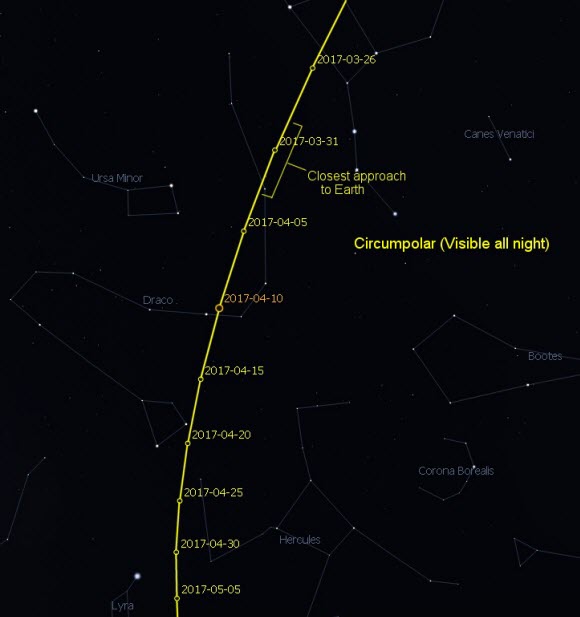
Tracking Comet 41P Tuttle-Giacobini-Kresák
April 2nd: Passes near the 3.6 magnitude star Thuban (Alpha Draconis)
April 5th: Passes just 0.15 AU (23.2 million kilometers) from the Earth at 13:30 UT. April 11th: reaches perihelion at 1.05 AU (162.7 million kilometers) from the Sun.
April 18th: passes the 2.7 magnitude star Rastaban (Beta Draconis)
April 2017 Sky Charts
Click each image to see a full-size Sky Chart:
Additional Image Credits:
- Planets and Comets where not otherwise mentioned: NASA
- Sky Charts: Stellarium Software
Events
Whitby Youth Hostel - East Whitby - rear of Abbey vistor centre. Book now: email whitby![]() yha.org.uk or call 01947 602 878 to reserve a space.
yha.org.uk or call 01947 602 878 to reserve a space.
Whitby Youth Hostel - East Whitby - rear of Abbey vistor centre. Book now: email whitby![]() yha.org.uk or call 01947 602 878 to reserve a space.
yha.org.uk or call 01947 602 878 to reserve a space.
 Whitby School - Room H1.
Whitby School - Room H1.
In Members' monthly meetings we usually take a tour of the night sky for the coming month using the Planetarium program. Have talks and presentations on various topics of astronomy/space etc, and discuss future events etc. New members welcome.


